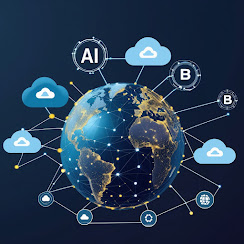Top 3 Next-generation Technological Solutions Changing the Face of Industries in 2025
Technology is advancing at an impressive rate. Businesses in almost all sectors have already gone beyond the fashionable early adoption and are leveraging new solutions to outsmart the competition. This article recognizes top three technical solutions which would change the face of industries completely by the year 2025, as envisioned by the experts-reproduction in business processes, efficiency in business operations, and potential in business profitability.
1.Automation using AI and ML
Artificial Intelligence and Machine Learning are no longer in their social sciences experimental mode, and are offered as a solution to every business. In 2025, the technologies will still transform industries, essentially by automating activities that previously required human intervention. They cover everything from customer service chatbots to advanced predictive analytics for improving decision-making and efficiency.
Artificial intelligence is being put to good use in industries like healthcare to analyze possible results in patients, create likely treatment plans tailored to a patient, and even assist in searching for new drugs. Retail is fast becoming an area where personalization in shopping is seen to be real; thus, the great extent to which AI automates inventory management and enhances supply chain optimization. Nowadays, businesses have adopted machine learning algorithms as the most effective means to process relatively huge datasets within a really short time, unearth patterns sometimes hidden and disperse them to make data-driven decisions using smarter operational strategies to lift overall productivity.
RPA, as it stands currently, appears to be one of the most promising applications of AI whereby machines operate parts of transferring repetitive, rule-based tasks across business units. Consequently, this involves operational cost savings, better accuracy, and above all, allowing employees to spend time on more valuable tasks.
2. Cloud Computing Meets Edge Computing: The New-Age Connectivity
Cloud is on everyone's lips, and each of such businesses is not the same as the others-in short, an idolized dream and new age. In particular, it symbolized real "revolution" for business customers, as it has now offered them not only reserving space for storing data, processing power, and hosting application but also "appearance" in 2025 with hybrid and multi-cloud strategies." Further, organizations adopt ended cloud solutions which equip the customers not only with cost efficiency but also with flexibility, security, and seamless collaboration during partnerships.
Cloud computing allows businesses to deploy their activities across geographical boundaries in real-time. The power of remote workforces is significant, they use cloud computing services to boost collaboration among distributed teams. With generating more and more enormous volumes of data, companies are likely to adopt edge computing so that data could be processed as much closer as possible to the source, thus reducing latency to improve speed. It is creating networks that are more efficient, reliable, and resilient by joining edges and clouds.
Even industries like manufacturing are now using cloud-based platforms for predictive maintenance, real-time analytics, and smart factory solutions. Such a technology within an organization helps monitor production lines remotely to prevent issues before getting out of hand, thus maximizing operational efficiency. -
3. Blockchain Technology for Improved Security and Transparency
The scope of blockchain technology has widened beyond birth in cryptocurrencies and is becoming a transformational technology in finance and supply chain. For healthcare, its decentralized and immutably tamper-proof nature provides a promise of transparency and security that even excellent traditional systems do not offer. It ensures an immutability of data, and thus has revolutionized the functioning of businesses in areas like transactions, data sharing, the keeping of records.
It has simplified cross-border payments in finance and minimized fraud and increased security with a transparent ledger of transaction in a supply chain. The introduction of blockchain technology has also helped track the origin of products. In addition to the benefits introduced to patients in hospitals or health care facilities, it guarantees some level of privacy in the provided transparent, immutable history of medical histories.
With the advance of smart contracts over blockchain technology, the scope of eliminating intermediaries from transactions while lowering costs and higher promptness and efficiency in dealing business is expected to be realized.
Conclusion
The evolution of technology today has made interesting innovations, such as artificial intelligence, cloud computing, and blockchain technology, that lead to digitally transforming the whole world. Availing some of these high-end technological solutions will improve operational efficiencies, transformation of customer experiences, and opportunities seized for enhancing their growth. Further on as time progresses into 2025, the merging of all these technologies will continue to evolve the future of industries around the globe in creating novel competitive benefits for companies all over the world.






%20setup.%20The%20image%20features%20a%20sleek%20computer%20monitor%20displaying%20a%20desktop%20environme.webp)
.webp)


.webp)

